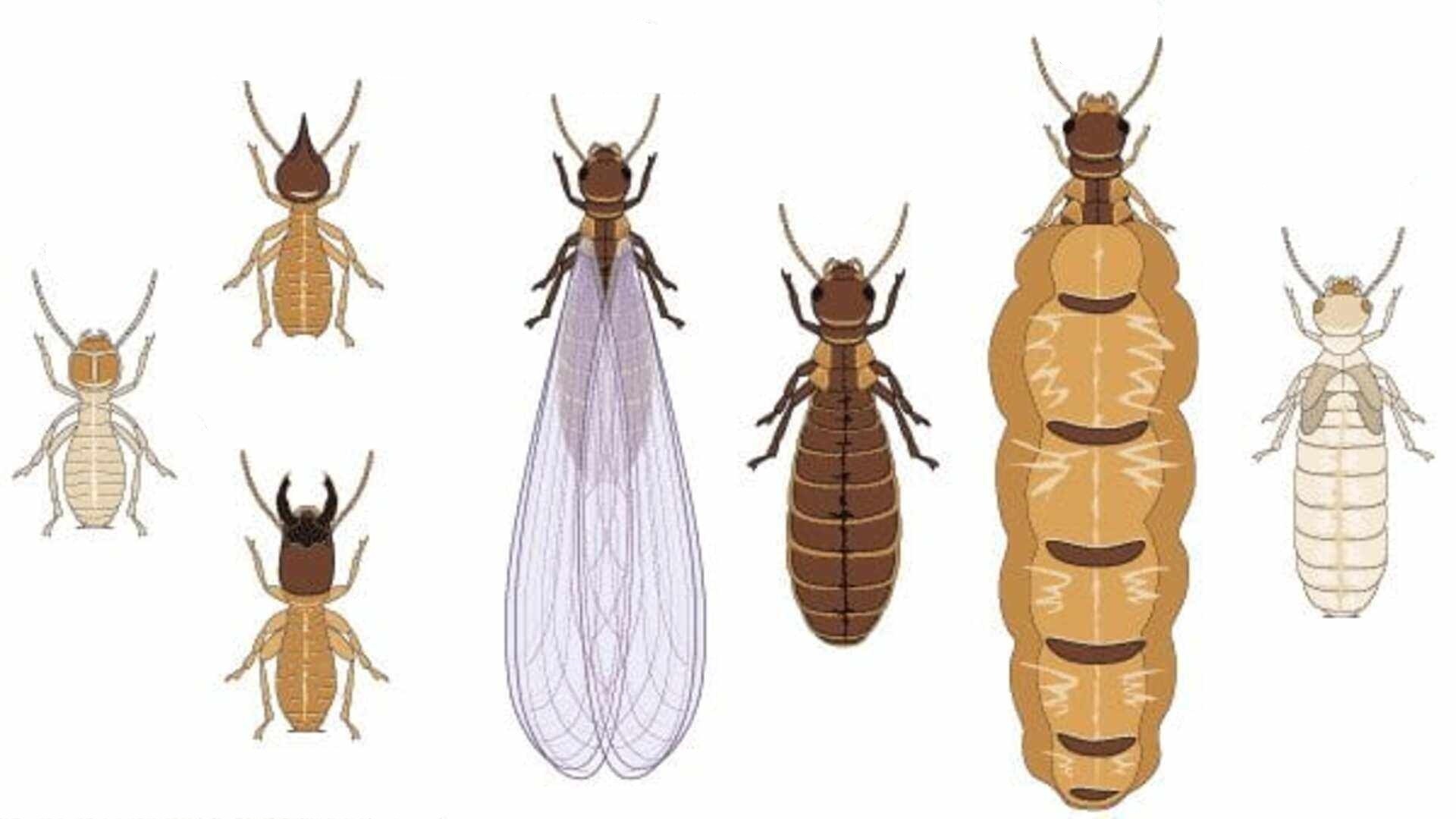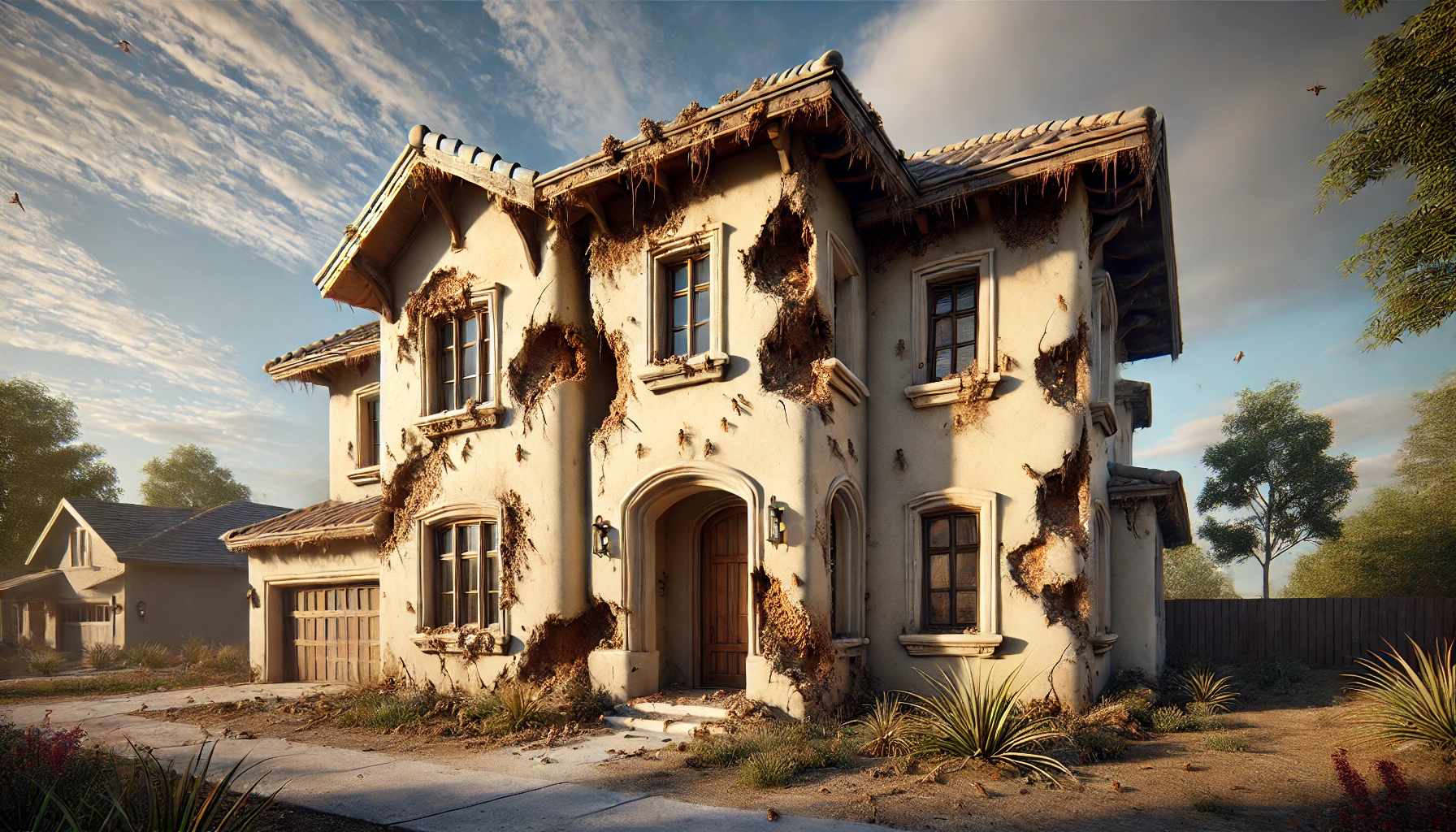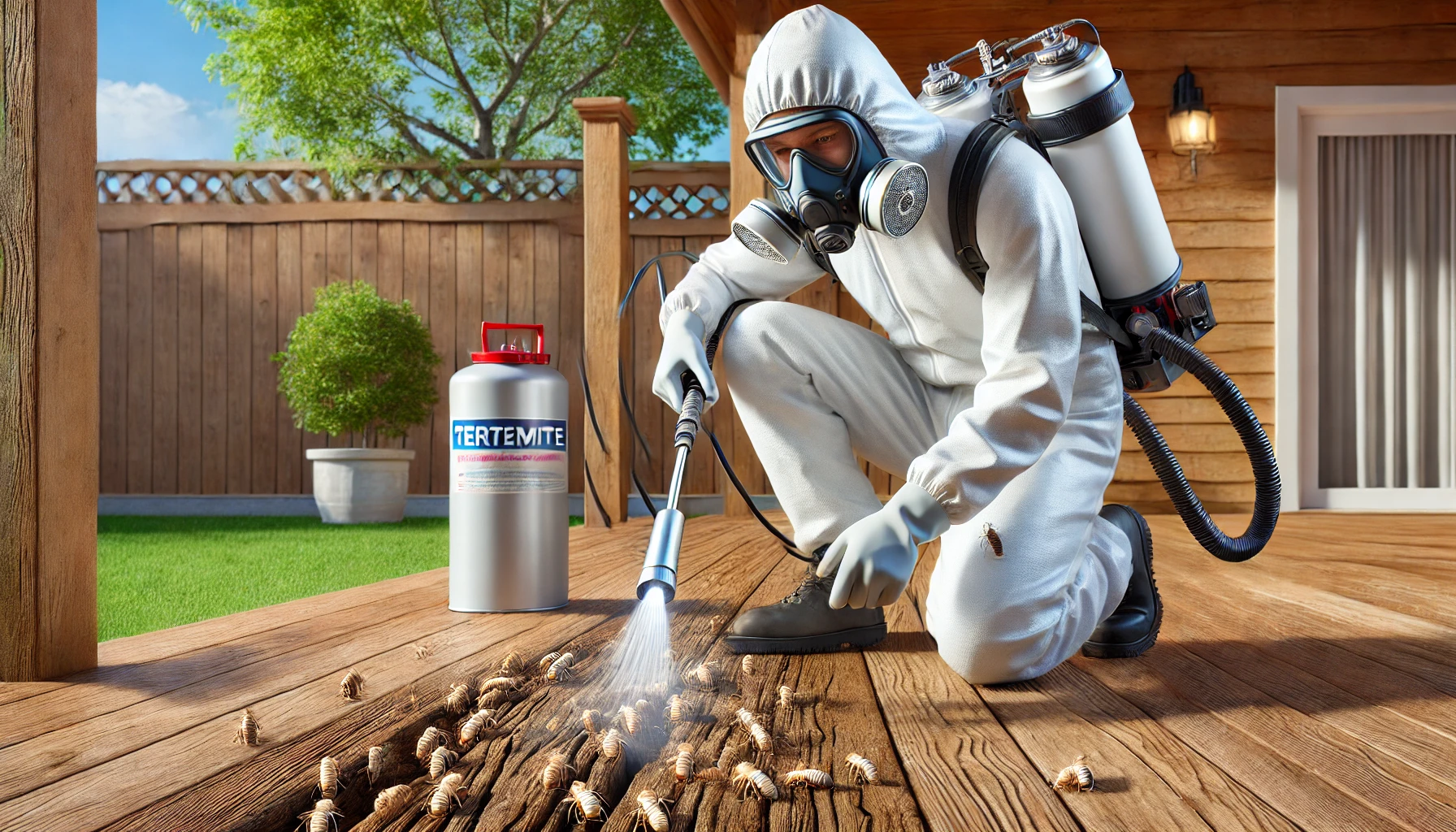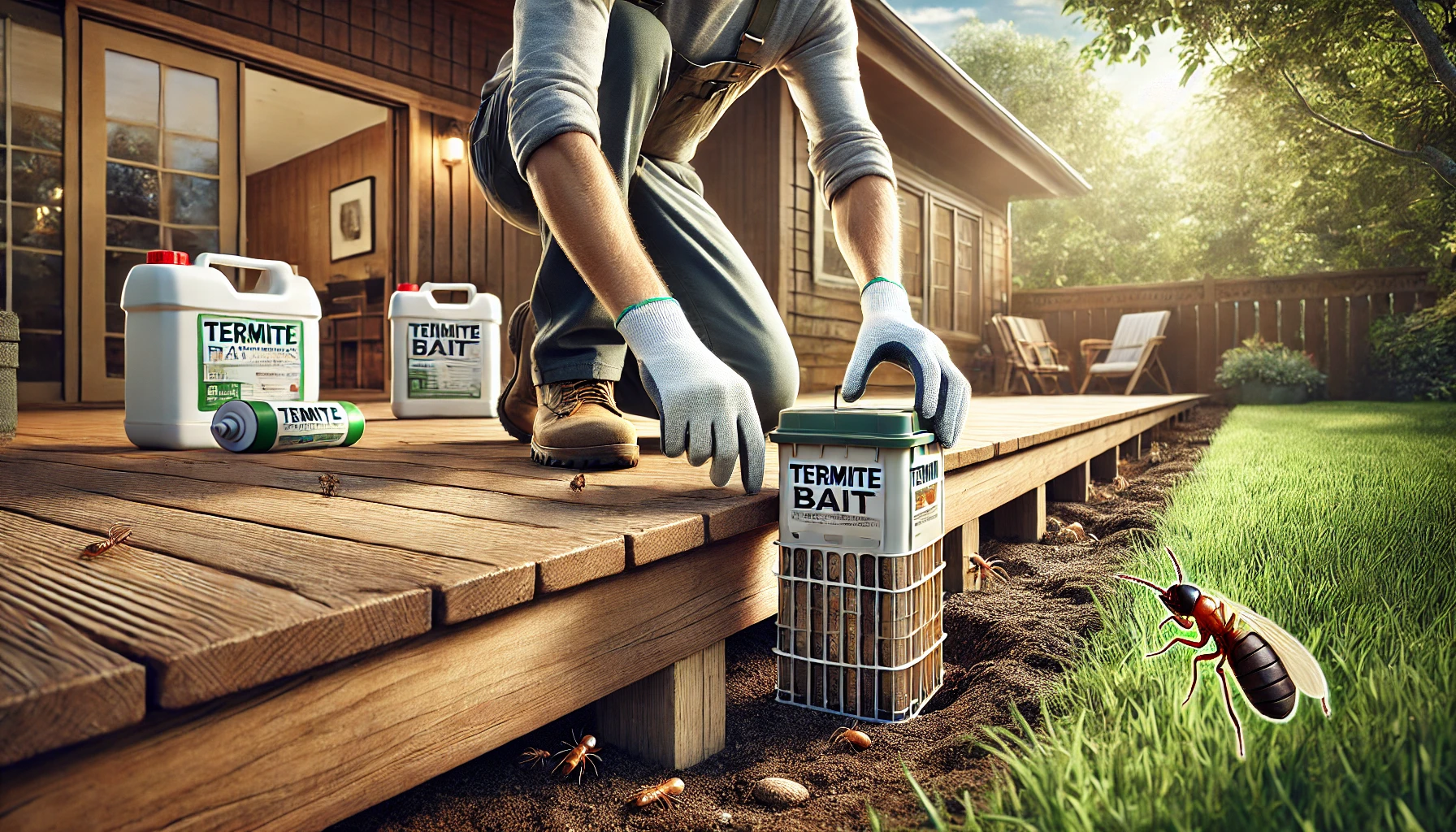Key Takeaways
- Stucco does not protect against termites.
- Termites can enter through foundation gaps and cracks.
- Foam insulation behind stucco allows tunneling.
- Look for mud tubes, hollow wood, and peeling paint.
- Regular inspections and treatments prevent infestations.
 Many homeowners believe that a stucco exterior protects against termites. After all, termites eat wood, and stucco is made from cement, sand, and lime.
Many homeowners believe that a stucco exterior protects against termites. After all, termites eat wood, and stucco is made from cement, sand, and lime.
However, this is a common misconception. Even if your home has a stucco finish, termites can still cause significant damage by finding hidden entry points into your home’s wooden structure.
Why Stucco Homes Are Still at Risk for Termites?
Stucco itself is not a food source for termites, but the wooden framework beneath is. Here are some key reasons why termites can still be a major threat to stucco homes:How Termites infest Stucco
-
Gaps Between Stucco and Foundation: In many homes, stucco extends below the soil line, creating a hidden gap between the stucco and the foundation. Subterranean termites can enter your home unseen through these gaps.
-
Cracks and Settling Issues: Stucco can develop small cracks due to house settling, temperature changes, or poor installation. Termites need only a 1/16-inch opening to slip through and reach the wooden structure behind.
-
Wood Trim, Eaves, and Window Frames: While walls may be covered in stucco, homes still have wooden window frames, door frames, eaves, and roof structures, which termites can easily infest.
-
Foam Insulation Behind Stucco: Some stucco homes use Exterior Insulation and Finish Systems (EIFS), which involve foam board insulation behind the stucco. While termites don’t eat foam, they can tunnel through it to reach wood.
-
Drywood Termites Can Enter From Above: In warm climates, drywood termites fly into homes through vents, roof gaps, or small cracks in stucco, bypassing soil treatments.


Not getting a solution?
Get your free pest control estimate today!Signs of Termites in a Stucco Home
Since termites often remain hidden behind stucco, detecting them early is critical. Here are the most common warning signs:Common Signs of Termite Infestation
-
Mud Tubes on Exterior Walls or Foundation: Subterranean termites build pencil-thin mud tubes to travel from the ground into a home. Check your foundation, stucco edges, and crawl space walls for these tubes.
-
Bubbling or Peeling Paint: Moisture buildup from termite activity can cause bubbling, blistering, or peeling paint on walls and wooden trims.
-
Small Holes in Stucco or Drywall: Tiny round holes in stucco or interior walls can indicate that termites have pushed through, often accompanied by termite droppings (frass).
-
Hollow-Sounding Wood: Tap on window sills, baseboards, and other wood near stucco walls. If it sounds hollow or crumbles easily, termites may have eaten the wood from the inside out.
-
Discarded Wings Near Windows or Light Fixtures: Swarming termites shed their wings after mating. If you find piles of wings near windows or light sources, it’s a strong sign that termites are nearby.

How to Prevent Termite Infestations in a Stucco Home
Taking proactive measures can significantly reduce your risk of a termite problem. Below are ways to protect your home:Ways to Prevent Termites in Stucco Homes
-
Keep Stucco Above Soil Level: If your stucco extends below ground, trim it back to expose the foundation and create a 2-4 inch gap. This prevents termites from entering unseen.
-
Seal Cracks and Gaps: Inspect your stucco exterior regularly for cracks and seal them with high-quality caulk or stucco patching compound.
-
Reduce Moisture Around the Home: Ensure proper drainage, fix leaks, and keep soil around your foundation dry by maintaining gutters and downspouts.
-
Maintain a Clear Perimeter: Avoid placing mulch, firewood, or plants too close to stucco walls, as they can provide a bridge for termites to enter.
-
Use Termite-Resistant Materials: When replacing trim, decking, or other wood near stucco, opt for pressure-treated wood, composite materials, or termite-resistant barriers.
-
Schedule Annual Termite Inspections: Professional termite inspections are the best way to detect an infestation early. Pest control experts use moisture meters and infrared cameras to check behind stucco for hidden activity.
-
Consider Preventative Termite Treatments: A pest control company can apply liquid termiticides or bait stations around your home’s perimeter to prevent infestations before they start.

What to Do If You Have Termites in a Stucco Home
If you suspect termites, act fast to prevent further damage. Here’s what to do:Termite Treatment Methods
-
Liquid Termiticides: Applied around the foundation to create a chemical barrier that prevents termites from entering and eliminates existing colonies.
-
Bait Stations: Lure termites to poisoned bait, which they carry back to the colony, effectively spreading the treatment and eliminating the infestation over time.
-
Fumigation (For Drywood Termites): Used when drywood termites have infested the entire structure, requiring the home to be tented and treated with fumigants to eliminate the termites.
-
Repair Termite Damage: Once termites are eliminated, repair any structural damage and seal entry points to prevent future infestations.
 If you feel things have gone out of control, it is advised to contact pest control professionals. Our team can provide a customized approach to protect your home effectively.
Visit our Species, Control, and DIY Guide sections for additional resources on termites and ways to tackle a termites infestation.
If you feel things have gone out of control, it is advised to contact pest control professionals. Our team can provide a customized approach to protect your home effectively.
Visit our Species, Control, and DIY Guide sections for additional resources on termites and ways to tackle a termites infestation.





